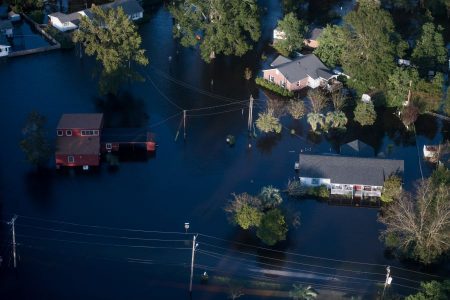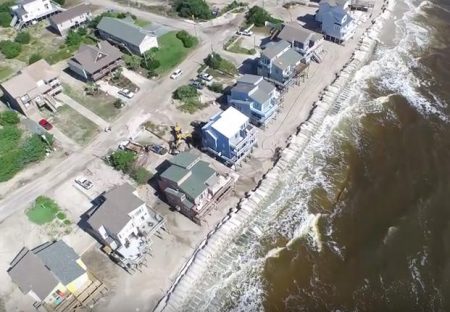September 19, 2018 – My wife and I are regular watchers of HGTV’s “Beachfront Bargain Hunt” where we see families seeking out homes on or near the beach on America’s three coasts. So many of these house hunts take place on barrier islands that face the Atlantic Ocean and the Gulf of Mexico. And nowhere do the realtors, or the house seekers ever consider just how vulnerable these beachfront properties are becoming.
Is it because the public lacks awareness of sea level rise?
Or is it the increasing intensity of ocean storms?
Or is it because governments are turning a blind eye to the future seashore communities face?
Take the example of North Carolina whose House of Representatives back in 2012 passed a bill that placed a 4-year moratorium on using forward-looking scientific evidence about sea level and coastal ocean threats. The law specifically limited the data coastal communities could use for planning to predict sea level rise and coastal erosion. The projections done by scientists based on modeling combined with historic and current data was to be put aside. Coastal communities from the Outer Banks to Wilmington were told, by their elected state officials, to ignore the best science could offer them for planning in light of global warming and accelerated rates of sea level rise.
Steven Colbert, currently a late-night talk show host, but back in 2012 the host of The Colbert Report made the following comment about North Carolina’s government stating, “If your science gives you a result you don’t like, pass a law saying the result is illegal.”
That’s exactly what the government did. It buried its head in the sand for four years. At the time the bill was passed, a scientific report predicted that by 2100, the ocean off the state’s coastlines would be a meter (39 inches) higher. The state legislators said no, that’s not right and put their own number on the future of sea level off the coast. In North Carolina, sea level rise was legislated to only go up by 20 centimeters (8 inches)! Currently, sea level rise of the Carolinas is between 3 and 5 millimeters per year. In 10 years that equates to 3 to 5 centimeters (1 to 2 inches). But that rate is accelerating so a decade from now the rise may be marginally higher, and then marginally higher again in twenty years. Add high tides and storm surges plus coastal erosion and you have a recipe for a creeping, insidious disaster. Based on the most recent analysis, 57,000 homes in North Carolina are likely to vanish as sea levels rise on that state’s coastlines.
And let’s not just pick on North Carolina. Texas legislators along with their governor at the time, Rick Perry, the current Secretary of Energy in the Trump administration, tried to remove references to climate change in a report predicting the future of Galveston Bay. And although the legislature and governor were unsuccessful, Texas remains in climate change denial even after the devastation of Hurricane Harvey last year.
Governor Rick Scott in Florida is cut from the same cloth as the North Carolina and Texas legislators. Words like global warming and climate change are banned from Florida’s official communiques.
And while Hurricane Florence may not directly be evidence of global warming, climate scientists argue that anthropogenic climate change is making storms like Florence worse. Why? Because a warmer ocean off the Atlantic coast combined with a warmer atmosphere creates a recipe for precipitation on a magnitude not normally seen in North America. In the last week, monsoon-like downpours from Florence combined with wind-driven storm surge to raise water levels above much of the state’s barrier islands and inundated numerous coastal communities.

This coastal and wetland flooding event should no longer be seen as a one in a century occurrence. Property damage to the two Carolinas is currently estimated at as much as $22 billion US. And the human disaster in loss of life although not as significant as Hurricane Maria in Puerto Rico, still remains immeasurable.
Who should take the blame? In the case of the Carolinas and the United States today, it is governments that are turning a blind eye to evidence brought to them by climatologists and other scientists. When scientists provide incontrovertible evidence of sea level rise and atmospheric warming, for the government to choose to ignore it is equivalent to perpetrating a fraud on the people. And the fraud continues since the end of the bill’s moratorium period of four years. The new regulations imposed on predictions of sea level rise now can only look 30 years into the future.
So what’s the result of all of this political sidestepping?
By the end of the century, 4.7 million Americans will be living in 2.5 million properties that are flooded regularly by rising sea levels. This represents a more than trillion dollar threat to coastal properties and the financial health of Americans whose personal wealth tends to be tied up in real estate. For places like Hilton Head in South Carolina, it means $1.5 billion in property will likely be underwater by 2045. In Charleston which regularly floods, home values since 2005 have dropped by $266 million.
The HGTV program shows beautiful homes lining shorelines with many of them on stilts. You would think that would be hint enough to prospective buyers that these are houses prone to floods. Yet the realtors promoting these properties, and the homeowners prepared to spend from $300,000 to as much as a million dollars for an oceanfront view, seem oblivious to the future reality. Flood insurance rates never get talked about. And no prospective buyer asks when was the area last inundated by the ocean.
















